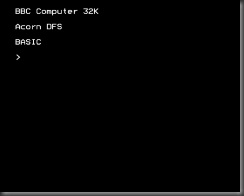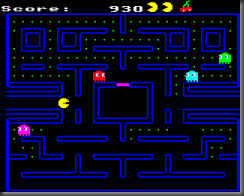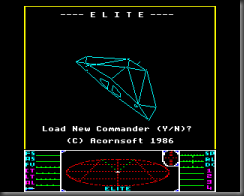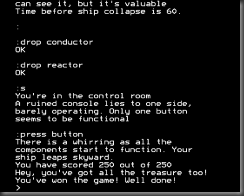In the circle I hung out with most of the popular computer models were present: the Commodore-64, Commodore Amiga, Vic-20, Dragon 32, Camputers Lynx, Sinclair ZX81 and the Sinclair Spectrum. All fine machines for various reasons, although the choice of materials used to create the keys of the ZX80, ZX81 and Spectrum still baffles me. The ZX80 and ZX81 had odd clicky, flat membranous keys and the Spectrum had rubbery, squishy keys…
Anyway, I didn’t have any of those models – I had a BBC Micro Model B (aka a Beeb). This was Acorn’s successor to the Atom and predecessor to the Electron and was to be called the Acorn Proton until the BBC took the machine on with its BBC Computer Literacy Project and pushed it heavily in the education sector.
The Beeb was never the best at graphics in comparison to some of the other machines more directly targeted at games, although many of the published games pushed its abilities to the limits as time drew on.
I cut my teeth with the Beeb, learning about how computers worked, having fun with graphical games and text adventures, and doing the other thing that was so common back in the early 80s. There were lots of magazines targeting these computers and they all had lots of program listings, which the keen and patient would painstakingly type in to get another little game to play.
Typing in published game listings was very commonplace. Typos in published game listings were also very commonplace. These two facts led to two results. Firstly, I learned how to type reasonably quickly, albeit the hunt and peck approach with a small subset of fingers (alas, to my chagrin, I never did learn to touch type). Secondly, thanks to a Breakout game that I spent a long time typing in from an issue of Computer & Video Games, and then spent days if not weeks not only fixing the typos, but also fixing the logic problems, by the time the game was working I had read so much of the BBC BASIC manual and the system reference manual that I had morphed into a BASIC programmer. So poor proofreading turned me into a coder. An unexpected result.
I had quite a few games for the Beeb and was not really that good at many of them (possibly due to lack of time investment in them) other than Aardvark Software’s Zalaga (a re-make of the arcade game Galaga, penned by Orlando). Some of the games were text adventures (apparently now termed interactive fiction) and I wasn’t very skilled at completing those either. The one that occupied me the most was Acornsoft’s Countdown to Doom by Peter Killworth.
 Recently, as an opportunity to show old-school technology to the younger generation, I found the BBC emulator BeebEm (which is just one of several emulators available, but is the one I’ve been playing with). This is an awesome endeavour, completely emulating various machines in the BBC Micros series, including the Model B and Model B Plus as well as the BBC Master 128. It even supports the second processors you add onto the Beeb (65C02, Z80 or ARM).
Recently, as an opportunity to show old-school technology to the younger generation, I found the BBC emulator BeebEm (which is just one of several emulators available, but is the one I’ve been playing with). This is an awesome endeavour, completely emulating various machines in the BBC Micros series, including the Model B and Model B Plus as well as the BBC Master 128. It even supports the second processors you add onto the Beeb (65C02, Z80 or ARM). The emulator web site has links to sites with images of various old games, so immediately I was lost in my own teenage years, bouncing from classic game to classic game.
The emulator web site has links to sites with images of various old games, so immediately I was lost in my own teenage years, bouncing from classic game to classic game.The Beeb was known for having various very faithful clones of arcade games released by the host software company Acornsoft. So for Pac-Man we had Snapper, Defender was Planetoid, Scramble was Rocket Raid, Galaxian was Arcadians, Frogger was Hopper.
 Of course there is the classic Elite (you can download it from the web site of one of the co-authors), which started life incomprehensibly squeezed into the Beeb’s paltry 32kB RAM. This set a new bar for games in such small devices and is said to be the title that set the mould for modern space flight simulation games. The idea was you were a space trader navigating around 8 galaxies each containing 256 planets. Between the planets you often were forced into battle with the Thargoids.
Of course there is the classic Elite (you can download it from the web site of one of the co-authors), which started life incomprehensibly squeezed into the Beeb’s paltry 32kB RAM. This set a new bar for games in such small devices and is said to be the title that set the mould for modern space flight simulation games. The idea was you were a space trader navigating around 8 galaxies each containing 256 planets. Between the planets you often were forced into battle with the Thargoids.
After all the colourful (and not so colourful) graphics I spent quite a few hours revisiting Countdown to Doom, finding the things I’d totally overlooked and then getting stuck again. I went through solving the puzzles, mapping the mazes, and collecting the ‘treasure’ initially on a PC version of the game I found, as the BBC version had some corruption and crashed out any time something unrecognised was entered.
 Then I worked out how to fix the corrupted line in the BASIC code and tried to replicate the solution there, only to find that the PC version was somewhat larger with more locations and items to collect and use. Either the low memory in the BBC put a fixed limit into what was possible to build in, or the game map was extended in the subsequent version coded for the PC. Also some of the commands had changed slightly, and multiple commands on one line were not available.
Then I worked out how to fix the corrupted line in the BASIC code and tried to replicate the solution there, only to find that the PC version was somewhat larger with more locations and items to collect and use. Either the low memory in the BBC put a fixed limit into what was possible to build in, or the game map was extended in the subsequent version coded for the PC. Also some of the commands had changed slightly, and multiple commands on one line were not available.But now, after a break of around a quarter of a century, I have solved Countdown to Doom.
Twice.
Yay!
Next stop is to see how the Nintendo 64 emulators have come along. The last time I tried them out, Goldeneye didn’t play so well in 1964, but I should probably do a quick compare of the current version of 1964 as well as Mupen64Plus, Project64 and MESS.
No comments:
Post a Comment